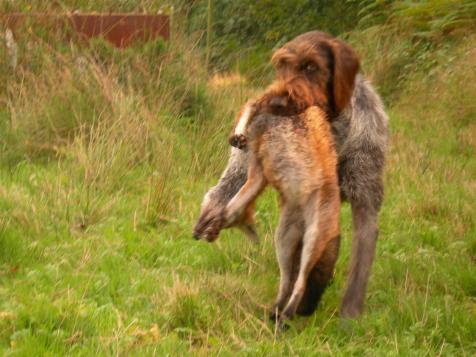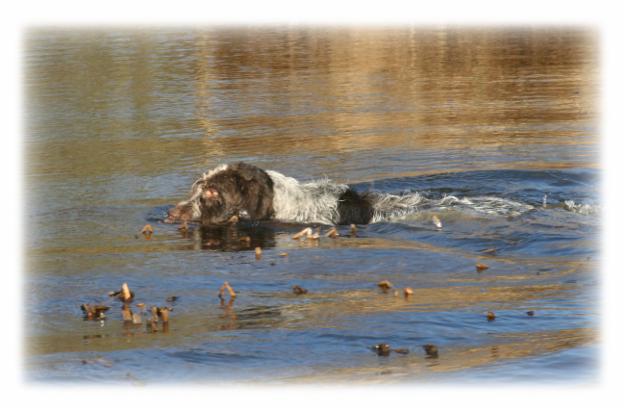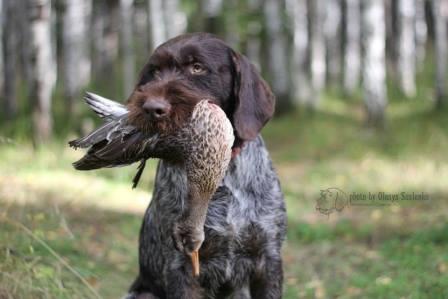German Breed and Performance Tests
On this page we have tried to give a very brief overview of what is expected from the young German hunting dog during its early years in the field. The JGHV is the umbrella organization for all hunting dog breed clubs in Germany. The purpose of the German breed tests is to determine the natural abilities of young Hunting dogs and to identify dogs which are especially suited for the breeding of versatile hunting dogs.
Verbands gebrauchsprufung (VJP) puppy test. The VJP is a German breed test held in the spring, the main purpose of which is to evaluate young dogs natural hunting ability. A dog that has passed this test provided it is handled correctly and has appropriate experience must be able to perform as a truly versatile dog in the hunting field. Young dogs are tested on the following
- Tracking The young dog will be evaluated on, the ability to track hares that are not visible to the dog, the dog working the track willingly with self control, and the manner with which the dog holds the track.
- Nose evaluated on the dogs use of the nose to, locate game, acknowledge game sent from a long distance, and briefly mark sent spots of game.
- Search evaluates the young dogs will to find game. The search must be industrious and persistent.
- Pointing a young dogs natural pointing ability will be evaluated with game birds, other game will be used if birds are not available. The dog must point or lie down before the game it has found. A staunch point is not necessary and chasing is not counted as a fault. Dogs which blink game can not pass the test.
- Cooperation and obedience The young dog must demonstrate a willingness to obey the command of it's handler during work. A dog is not required to be steady on game at this point, but can not pass the test if they constantly evade their handlers.
- Gunshot soundness evaluated with at least 2 shotgun shots fired at an interval of at least 20 seconds apart while the dog is hunting 30-50 meters away. If sensitivity is shown the test will be repeated after at least 30 min have elapsed.

Herbstzuchtprufung (HZP) Fall Breed Test The HZP is a German breed test to determine how the natural abilities of the young dog are developing. Held annually in the autumn, Only dogs bred under the Verein Deutsch Drahthaar (VDD) breeding regulations are eligible for entry to this event. The purpose of the HZP is to promote development of the natural hunting abilities of the young dog in view of its suitability, and future use, as a versatile hunting dog and as a breeding dog. Emphasis is placed on the hunting dogs work after the shot and pays special attention to natural hunting abilities and sound temperament. The event is held under the rules of the German Hunt Test Association the JGHV. Dogs are tested on the following;
·Tracking tested on tracks of Hares, or if the handler wishes rabbit, that are no longer visible. The evaluation is made on the way the dog starts and adapts to tracking, if the dog works with self control, willingness and confidence, and whether the dog makes every effort to follow the track even under difficult conditions.
· Nose evaluated on how frequently the dog finds game, acknowledges game scent from a long distance, briefly marks scent spots of game and occasional marking of songbird scent. The dogs’ reaction when it loses, crosses, or relocates game will be noted.
· Search in this test the main emphasis will be placed on the dogs will to find. The search should be methodical and persistent. Dog to be approximately 20 meters from handler and must be obedient on hare.
· Pointing preferably tested on game birds, but other game can be used. The dog is expected to point or lie down before game it has located. A higher mark is given if the dog holds the point or remains lying down until the handler has approached, or the game has moved on.

· Water work the purpose of this test is to evaluate the young dog for its future use in retrieving wounded or dead waterfowl. The test is conducted in a pond or lake with sufficient cover for a duck to fully utilize its flight capability, and will be sufficiently large and deep enough to force the dog to swim. The dog is tested on;
1 soundness to gunshot by a shot duck being thrown as far as possible into the open water while the dog is watching. The dog must enter the water within one minute. While the dog swims to retrieve the duck a live shot is fired into the water in the direction of the dead duck. The dog must retrieve the duck without further command. A dog that fails this test cannot continue the rest of the test.
2 A blind retrieve from dense cover a dead duck is thrown, unseen by the dog, into the cover at least 30 meters from the dog in deep water. The dog is sent across open water to the cover and must start to search for the duck from this point. The dog must find and retrieve the duck to its handler. Help from the handler will lower the dogs score.
3 Search in densely vegetated water a duck is released into the cover unseen by the dog. The direction of the duck will be indicated to the handler, and the dog is commanded to retrieve. The dog should search and find the duck without further command. As soon as the duck is flushed by the dog, the duck is shot by the handler and must be retrieved by the dog without further command.
4 Retrieving of the duck should be performed by the dog carrying the duck properly to the handler, sits down and delivers correctly.

Photo Olesya Nedelcheve (Russia)
· Retrieving of feathered game shot in front of the dog and retrieved to the handler. Evaluated on the working and blind retrieve of a winged partridge/pheasant to its handler. The dog should search in front of the handler at a controlled speed demonstrating good use of nose and a will to find game.